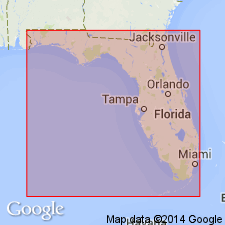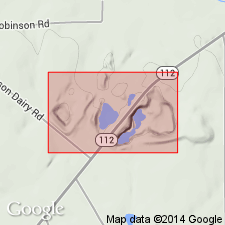
- Usage in publication:
-
- Duncan Church beds
- Modifications:
-
- First used
- Dominant lithology:
-
- Limestone
- AAPG geologic province:
-
- South Georgia sedimentary province
Summary:
In FL panhandle, the Oligocene is separable into Byram Formation, Marianna Limestone, and sediments differing from peninsular Suwannee Limestone, to which name Suwannee has been extended. The panhandle Oligocene sediments of Suwannee age are light gray to buff porous extremely fossiliferous coarse carbonate clastics composed of large numbers of LEPIDOCYCLINA sp., OPERCULINOIDES sp., mollusks and echinoids. These rocks could be more accurately referred to "Duncan Church beds." However, naming of this distinctive lithologic unit will be delayed until present drilling program is completed and until sediments can be traced from these exposures into adjacent exposures, particularly in Glendon, AL, area. Overlies Byram Formation.
Source: GNU records (USGS DDS-6; Reston GNULEX).

- Usage in publication:
-
- Duncan Church beds
- Modifications:
-
- Biostratigraphic dating
- Revised
- AAPG geologic province:
-
- South Georgia sedimentary province
Summary:
Duncan Church beds of early Oligocene age included in Bridgeboro Limestone. Correlation of Duncan Church beds, Bridgeboro Limestone, and Glendon Limestone based on biostratigraphic and lithostratigraphic considerations. Larger Foraminifera indicate a Vicksburgian age assignment for all three.
Source: GNU records (USGS DDS-6; Reston GNULEX).
For more information, please contact Nancy Stamm, Geologic Names Committee Secretary.
Asterisk (*) indicates published by U.S. Geological Survey authors.
"No current usage" (†) implies that a name has been abandoned or has fallen into disuse. Former usage and, if known, replacement name given in parentheses ( ).
Slash (/) indicates name conflicts with nomenclatural guidelines (CSN, 1933; ACSN, 1961, 1970; NACSN, 1983, 2005, 2021). May be explained within brackets ([ ]).

